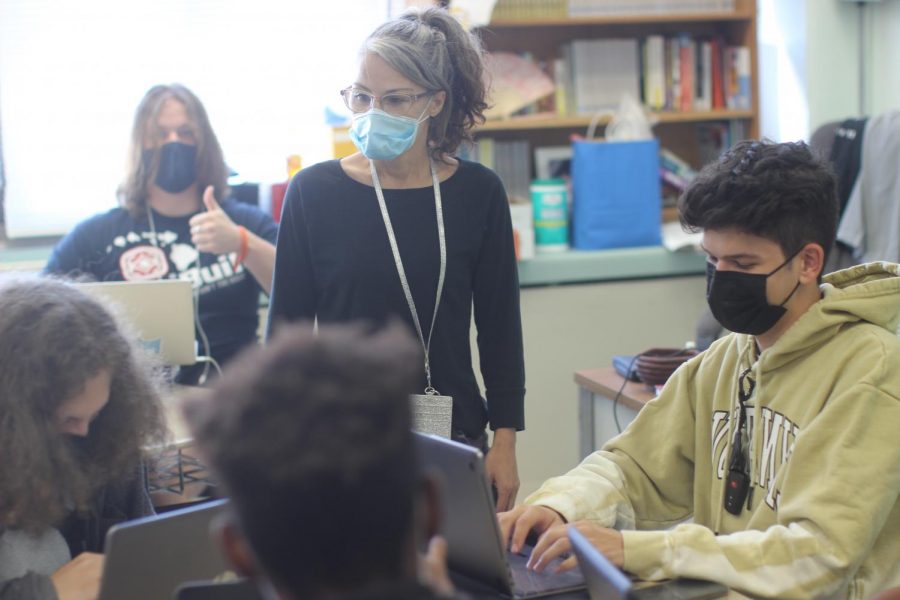‘No one’s looking out for those kids’
CHECKING IN: English teacher Bree Rolfe walks around her classroom, monitoring senior Cristian Vockell’s progress. Rolfe received the COVID-19 vaccine in January and recently got a booster shot because she has cystic fibrosis.
October 26, 2021
High-risk and immunocompromised Bulldogs reflect after a year and a half of COVID-19
Caulin Wagner knew something was wrong when he felt extreme pain in his left leg.
Wagner, a senior, went to his doctor and was diagnosed with osteosarcoma, a common type of bone cancer.
“When I realized that I had it I think I was almost about to tear up because I didn’t know that it would actually happen,” Wagner said. “But if it weren’t for the nurses that helped me heal up, I wouldn’t be here by now.”
Wagner no longer has osteosarcoma; he completed chemotherapy and proudly talks about how he beat cancer.
“The chemotherapy was awful,” Wagner said. “I kept on throwing up repeatedly because it was so bad. I needed to have it anyway because it’s very important [for] chemo to be in your system because you have a higher risk for dying. Luckily, the system in my body was very tough and strong and I managed to actually beat [cancer].”
Since the start of the COVID-19 pandemic, Wagner has had to adjust his habits. According to the CDC, having cancer makes one more likely to have a severe case of COVID-19.
“I’m kind of scared of getting [COVID-19],” Wagner said. “But as long as I’m careful and stay three to six feet apart, then I’m going to be okay.”
Wagner is not the only student or teacher with a potentially increased chance of having a severe case of COVID-19.
Every Saturday night, English teacher Bree Rolfe logs onto Zoom to hangout and play games with her friends. The virtual hangouts are a safe way for Rolfe, who has cystic fibrosis, to connect with her friends during the pandemic. Rolfe is one of an estimated 30,000 Americans with cystic fibrosis, a genetic disease that affects the lungs and pancreas.
“One of the positives about the pandemic was that everyone discovered Zoom,” Rolfe said. “My best friend lives in Massachusetts and I have really good friends in the Palm Springs area, and we discovered Zoom. We’re like, why don’t we hang out every Saturday night on Zoom and play Jackbox games? So I did a lot of stuff like that with my friends who lived elsewhere.”
While Rolfe says that she isn’t too concerned about her risk of contracting COVID-19, she worries more about immunocompromised and high-risk students who have to attend in-person school.
“One of the things that’s really makes me angry about Texas, and about this whole situation is that, my concern is for the students who are like me, like when do we start caring about them,” Rolfe said. “There have been people who have gone here that have had cystic fibrosis or other conditions and I feel like they’ve been left out of the conversation, especially in Texas, like that nobody is looking out for those chronically ill kids who are having to come back to school.”
Rolfe was unable to attend the graduation parade for the class of 2020 because she has cystic fibrosis.
“I missed out on lots of things,” Rolfe said. “Some of [my seniors] were like ‘where’s Ms. Rolfe?’ and my colleagues were like ‘she can’t leave the house.’ It was heartbreaking for me to not say goodbye to my seniors.”
For many high-risk people, including junior Carey Wooley, who has rheumatoid arthritis, getting a booster dose of the COVID-19 vaccine was the right choice for them because of their condition. The FDA and CDC recently approved booster doses for eligible individuals.
“As a high risk individual I am always so afraid of getting COVID-19 but having the booster shot of the vaccine gives me so much relief as it feels like an extra layer of protection,” Wooley said.
Although CDC data shows that children are dying from COVID-19 at a lower rate than older age groups, the increased transmissability of the Delta variant has led to an increase in hospitalizations for COVID-19 among children.
“Every time you see it’s like, ‘oh, the only people who are getting sick or have underlying conditions’ and I’m like, you’re saying that in a room with people who have children with underlying conditions and it’s like, oh, only your kid will die is terrible, it’s terrible,” Rolfe said.
The potential removal of mask mandates in Austin ISD due to Governor Abbott’s executive order is a concern to some students, including Wagner.
“I would feel really angered,” Wagner said. “COVID is still here, because if it was gone, people would have the mask off. We’re still living in a state where someone brought COVID and there are still people who aren’t smart enough to know that masks are indeed mandatory for stores, schools, everywhere, meaning wear a mask at all times necessary.”
For Rolfe, adjusting to the return of fully in-person instruction isn’t always easy.
“We’re dealing with students who haven’t been to school in two years,” Rolfe said. “[I’m] reminding myself that this is a pandemic, and I have to kind of tailor my expectations. I no longer am like trying to be the best, most amazing teacher on Earth. I’m just trying to make sure my kids learn something and cutting myself and my students some slack.”
Rolfe returned to in-person teaching last February after getting vaccinated.
“I just hope that our students at Bowie who are immunocompromised or high risk are safe and happy,” Rolfe said. “I hope that we find a way to make being able to come back [to in-person school] a thing for them.”










